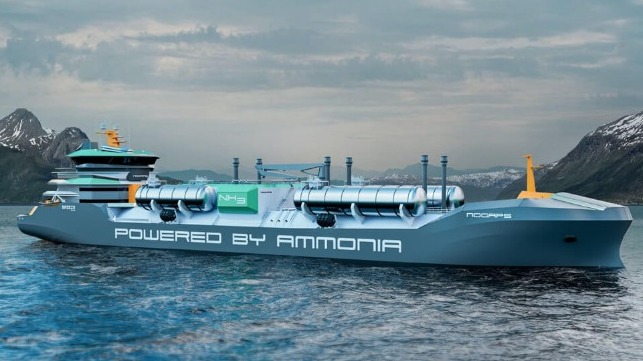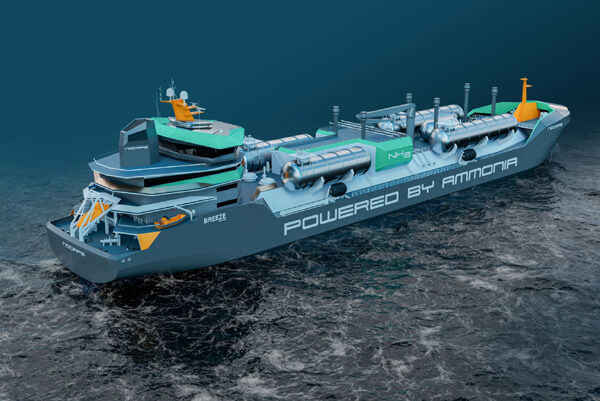Initial Designs Presented in Project for Ammonia-Fueled Gas Carrier

The Nordic Green Ammonia-Powered Ships (NoGAPS) project reports it has completed the first phase of an effort to develop an ammonia-fueled gas carrier, m/s NoGAPS, and has completed an initial design as they work to produce a detailed ship design. Having completed the proof of concept, they look to introduce the demonstration vessel in the Nordic region in 2024 or 2025 in an effort to accelerate the adoption of ammonia-fueled propulsion.
The project brief highlights that ammonia has been identified as one of the leading potential zero-emission fuels as it can be produced from renewable electricity and is already produced in large quantities including in the Nordic countries. However, they recognize that ammonia-powered vessels also present several challenges, including technology, safety, fuel supply, and commercial viability, that must be overcome before the promise of ships running safely on green ammonia can become a reality. These considerations were incorporated in this feasibility assessment in addition to using DNV Rules and the IGC Code as the regulatory basis for the project.
The first phase of the project ran from 2020 to 2021 focusing on developing a proof of concept on how the barriers to the adoption of ammonia as a zero-emission maritime fuel can be overcome. They addressed the considerations for safety and efficiency, sustainable and steady fuel supply chains, as well as commercial viability.
During the current phase, the project will produce a detailed ship design for an ammonia-powered ammonia carrier, the M/S NoGAPS, which they highlight will lay the foundation for a shipyard tender and the construction of the vessel. Among the challenges they are addressing to finalize the design is safety ranging from the materials and configuration for fuel storage and engine room to the containment systems and crew placement. They are also working to determine the optimal tank sizing and placement and the expected energy efficiency of the vessel.

Two main machinery configurations were assessed as part of the feasibility phase, weight the option between an ammonia-electric propulsion system with four-stroke main engines and an ammonia-mechanical solution with a two-stroke main engine. The assessment of the machinery configurations concluded with selecting the two-stroke option, mainly driven by the lower fuel consumption and reduced emissions for the option. They also report that the configuration also contributes to a simplified safety concept with a single ammonia consumer onboard that maximizes the emission reduction potential of ammonia as a fuel. The main engine will be the only ammonia consumer with auxiliary engines and a boiler, if needed, being fueled by conventional or biofuels.
In addition to the propulsion system design, the feasibility phase related to accommodation location and machinery configuration, other design aspects, including fuel tank location and dimensioning, bunkering capability, and ship stability. The study concluded that further research on the vessel’s bunkering capability, including installing a bow thruster, was needed as it presents a flexible option for the vessel’s owner.
The project has now entered the initial design phase to incorporate the key decisions and outcomes from the feasibility phase, which provided the basis for a 22,000 cbm capacity gas carrier. In this phase, they will increase the level of detail and analysis, including kicking off the initial design development, a hazard identification (HAZID) qualitative risk assessment workshop, and optimization of vessel efficiency. This will be used for the submission of design drawings and documentation to target an approval in principle from DNV, and, finally, an initial design package that can be used for submission to shipyards for official tenders.

that matters most
Get the latest maritime news delivered to your inbox daily.
The medium-term objective is to have the m/s NoGAPS in commercial operation working with partners Yana and BW Epic Kosan. The first ship would operate in the Nordic region serving as a demonstration ship and providing additional research on ammonia operations. By 2025, the project organizers want to establish the infrastructure, operational and business models for ammonia-powered shipping in the region. They believe this will accelerate the decarbonization of the Nordic maritime ecosystem, stimulate investment and job growth in the sector, and create a leading position globally for Nordic companies throughout the value chain.
The Mærsk Mc-Kinney Møller Center for Zero Carbon Shipping (MMMCZCS) is leading the vessel design work for NoGAPS in close collaboration with project partners Nordic Innovation, Global Maritime Forum, BW Epic Kosan, Yara International, MAN Energy Solutions, Wärtsilä Marine, DNV, Danish Maritime Authority and the external ship designer Breeze Ship Design.
